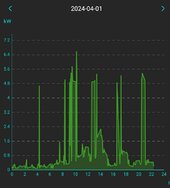Total newbie here so please bear with me if I'm asking stupid question. I do have general knowledge about Volt, Amps, W/hr and such. I'm looking for a all in one expandable battery/inverter with solar charging. Main reason I want a commercially available pre-built is that I will probably be downsizing in the next 5 years or so and a system that can be easily moved would simplify thing. I don't mind leaving the solar panels in place as it'll probably adds to the marketability of the house anyways.
My current resident is a 2 story 2200 sq ft house in San Jose/Cupertino border. House have insulated wall and was remodeled with new double pane windows pretty much all LED lighting and insulated water pipes 2 years ago.
Both the Anker and Ecoflow have home panel that can take more than one inverter (2 with Anker and 3 with EcoFlow) which would give me output currents ranging from 6000 Watts to 21.6KW. I know the house uses between 900-1000KW per month depending on seasons. so say 30-35KW a day. but I do not know how much output current I need to handle surges when varies appliances starts up or happens to be on at the same time.
I assume the biggest surge/constant power draw (above 1000W for longer than say 10 minutes at a time) would be HVAC, Electric Stove top, Cloth dryer. What would the minimum recommended current output ( let say I make sure that the HVAC is off when I use the cloth dryer or during cooking hours) with the rest of the constant power draw being from 2x300W Fridge. PC setup with sound system that probably draw around 300W and 2 200W QLED TV that's on for a total of maybe 4 hours a day.
So the main question is how much output do I need. I'm sure I'm going to be cutting it close with a 6000W Anker but will a 7200W Ultra be enough. We can worry about capacity later as both system are easily expandable. Thanks in advance for all inputs.
My current resident is a 2 story 2200 sq ft house in San Jose/Cupertino border. House have insulated wall and was remodeled with new double pane windows pretty much all LED lighting and insulated water pipes 2 years ago.
Both the Anker and Ecoflow have home panel that can take more than one inverter (2 with Anker and 3 with EcoFlow) which would give me output currents ranging from 6000 Watts to 21.6KW. I know the house uses between 900-1000KW per month depending on seasons. so say 30-35KW a day. but I do not know how much output current I need to handle surges when varies appliances starts up or happens to be on at the same time.
I assume the biggest surge/constant power draw (above 1000W for longer than say 10 minutes at a time) would be HVAC, Electric Stove top, Cloth dryer. What would the minimum recommended current output ( let say I make sure that the HVAC is off when I use the cloth dryer or during cooking hours) with the rest of the constant power draw being from 2x300W Fridge. PC setup with sound system that probably draw around 300W and 2 200W QLED TV that's on for a total of maybe 4 hours a day.
So the main question is how much output do I need. I'm sure I'm going to be cutting it close with a 6000W Anker but will a 7200W Ultra be enough. We can worry about capacity later as both system are easily expandable. Thanks in advance for all inputs.



